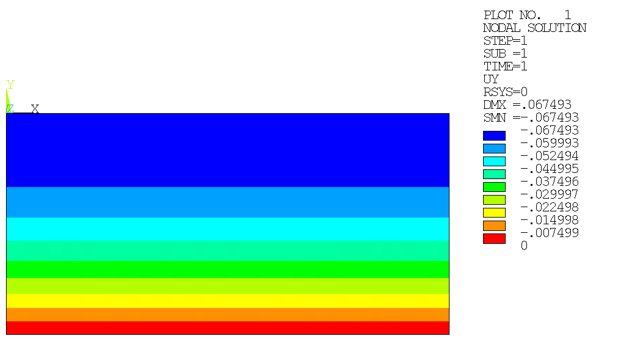A nonlinear static analysis is performed using the initial Newton-Raphson option.
The in situ stress state is calculated using a single substep.
The active and passive pressure-state loads are applied via 10 initial and 100 maximum substeps with automatic time-stepping enabled.
Calculating the in situ stress state in the first load step results in vertical displacements:
Generally, the soil exists in an already consolidated state. Initial displacements due to at-rest loads are therefore unnatural and should be minimized.
The vertical stress state varies linearly with the depth of the soil, expressed as:
where:
|
|
|
|
|
|
The coefficient of lateral earth pressure is the ratio of horizontal to vertical
stress components. For a horizontally retained non-overconsolidated soil under
elastic loading conditions, it is defined (via Poisson’s ratio ) as:
so that the horizontal stress components can be calculated as:[2]
The known stress state is directly applied during solution (INISTATE,DEFINE).
The following figure shows that the initial at-rest pressure state is correctly applied, while the soil structure retains its initial shape:
For more difficult cases involving curved retaining walls or complex outside loadings, for example, a different approach is necessary for defining the initial stress state:
Determine the initial stress state via a standard finite element calculation.
Write the results to an .ist file.
Recalculate the initial state using the initial calculation results in the .ist file.
Example 48.1: Recalculating Initial Stress State Using Results from a Prior Calculation
/solu ! Enter the solution processor time,1 ! Write stresses to .ist file at solution inistate,write,1,,,,,S … ! Solve the first load step and finish the solution processor solve finish /solu ! Enter the solution processor again ANTYPE,STATIC,NEW time,1 ! Activate the restart option for use in the active/passive pressure load steps rescontrol,define,1,last ! Read the previously calculated stress state from .ist file inistate,read,file,ist ! Ensure that the initial configuration is applied in one substep nsubst,1,1,1 … ! Solve the first load step again and finish the solution processor solve finish
After the structure has been correctly initialized via the gravitational load step, all subsequent loadings can be applied.
Both the active and passive pressure-state conditions are generated via a multiframe restart (ANTYPE,,RESTART) of the initial in situ stress step.
Example 48.2: Calculating Active and Passive Stress States
/solu ! Enter the solution processor time,2 ! Specify a restart at the last substep of the first load step antyp,,restart,1,last … ! Solve the second load step and finish the solution processor solve finish




